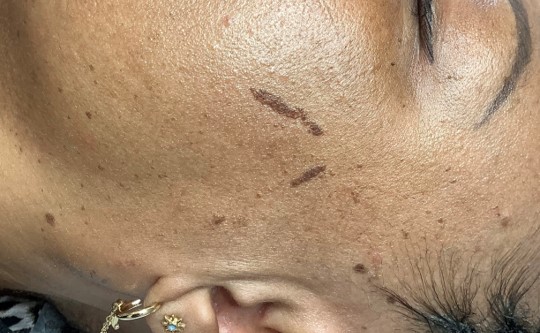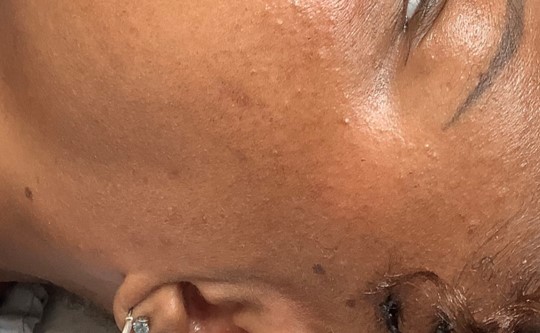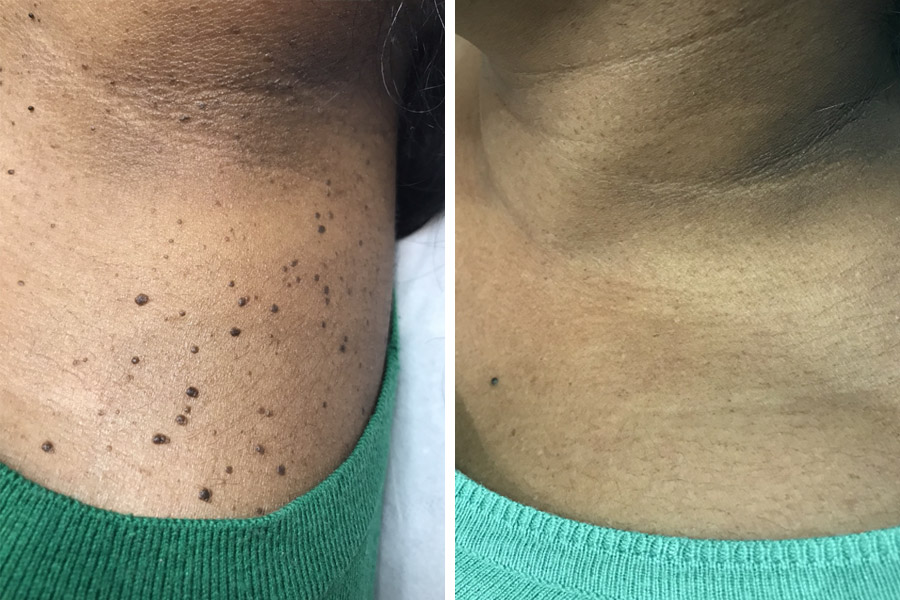
 DRAG
DRAG
What is Dermatosis Papulosa Nigra?
Dermatosis papulosa nigra (DPN) is a common and benign skin lesion. It typically presents in adolescence and can develop in size and number with increased age. Those most affected by this skin concern are people of colour of Black African, Asian, and mixed heritage backgrounds, predominantly within the Fitzpatrick skin type classifications 4-6.
It can present as individual scattered lesions that are black or dark brown in colour. They can be either flat, slightly raised or noticeably raised against the skin’s surface. These lesions will likely usually measure between 1-5mm in diameter.
Commonly occurring on the cheekbones, temples and around the eyes, dermatosis papulosa nigra can also form on the rest of the face as well as the neck, chest, and back. It is believed that areas more exposed to sunlight are likely to develop this skin concern. Some cases can be mild with only a small number of lesions, while others may find that they have a high concentration of dark spots or bumps spread across multiple areas.
Although this condition is not medically concerning, its development can be cosmetically undesirable to some. We offer advanced electrolysis at our Wimbledon and Kensington clinics as an effective treatment to help improve the appearance of dermatosis papulosa nigra.
What Treatments are Available for Dermatosis Papulosa Nigra?
Dermatosis papulosa nigra is a common, benign, and harmless skin condition that does not require medical treatment. However, if its appearance affects your confidence and self-esteem, cosmetic treatments can be used to visually improve the appearance of the affected areas.
Advanced electrolysis is offered at both our Wimbledon and Kensington clinics to improve the appearance of DPN effectively. The treatment works by using an electric current and a very fine needle to cauterise a skin imperfection.
Our experienced and highly trained practitioners will use a sterilised disposable probe alongside a variable current during an advanced electrolysis treatment. This produces a heating effect that causes its structure and content to coagulate or dry up when applied to the blemish. Your practitioner will work carefully when treating your dermatosis papulosa nigra, to ensure no healthy skin is affected.
After the treatment is complete, your skin begins its healing process. During this process, the treated lesion will crust over or form a scab, which can take anywhere from 5-14 days to drop off, or slightly longer on the body. It is important that during this period, you do not pick or scratch any scabbing which appears to avoid disrupting the healing and potentially triggering any hypo- or hyperpigmentation to develop.
Advanced electrolysis is a relatively quick and straightforward treatment method for dermatosis papulosa nigra. The procedure will cause no prolonged or residual pain. However, you may experience a stinging sensation that can be mildly uncomfortable, but our professionals can talk you through how this can be managed. Once your session is complete, our practitioners will indicate whether follow up treatments are necessary – in cases where there is a large coverage of lesions, multiple sessions may be required.
If you would like to remove and improve the appearance of dermatosis papulosa nigra, please get in touch with us today. Here at Eden Skin Clinic, our specialists will professionally treat mild to severe cases of DPN at both our Wimbledon and Kensington clinics.
What Causes Dermatosis Papulosa Nigra?
The exact cause of dermatosis papulosa nigra is largely unknown. However, around 50% of those affected will report a family history of DPN, either from an affected parent or grandparent. Although most research suggests that dermatosis papulosa nigra is inherited, it may also be triggered by excessive sun exposure.
Regular contact with UV light, either through sunlight or sunbeds, is thought to trigger an excess of epidermal cells. This can be exacerbated by the belief that sun protection is unnecessary for higher Fitzpatrick skin types as the skin is not likely to burn. An overgrowth of these cells can contribute to the formation of dermatosis papulosa nigra. Over time, this presents as a hyperpigmented papule on the skin’s surface.
Most individuals will develop DPN in adolescence. However, adolescence itself is not considered a trigger for this skin concern. With age, you may notice that the lesions’ occurrence, number, and size increase due to repeated sun exposure or sustained friction on the skin. They may also develop a rougher appearance and small flaps similar to those found on skin tags.
Dermatosis Papulosa Nigra Treatment Costs
If you are interested in advanced electrolysis to treat your dermatosis papulosa nigra, please get in contact with Eden Skin Clinic today. We would be happy to assess your skin condition and carry out the required patch testing, working with you to create a bespoke treatment plan. We can book your first treatment session around 2-3 weeks after your consultation and patch test.
Please fill out our online consultation form if you are ready to get booked in for our treatments. We will get back to you shortly to schedule an appointment.
For more information about our prices, please view our prices in Kensington and Wimbledon respectively.
You may call us at either of our Central London clinics in Wimbledon or Kensington. Our expert team are on hand to answer your questions and help you find a treatment that suits your needs and achieves your goals.






